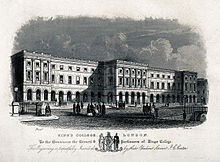User:Deminisher/sandbox/Physics Department, King's College London
| This is not a Wikipedia article: It is an individual user's work-in-progress page, and may be incomplete and/or unreliable. For guidance on developing this draft, see Wikipedia:So you made a userspace draft. Find sources: Google (books · news · scholar · free images · WP refs) · FENS · JSTOR · TWL |
 Strand campus engraving | |
| Established | 1831 |
|---|---|
| Affiliation | King's College London |
| Head of Department | Chris Lorenz |
| Location | , United Kingdom 52°12′33.35″N 0°05′31.24″E / 52.2092639°N 0.0920111°E |
| Clerk Maxwell Professor of Theoretical Physics | John Ellis |
| Website | www |
The Department of Physics at King's College London is the oldest experimental Physics department in England. The bulk of its teaching and operations are located in the Strand and King's building of the university's Strand campus. However, the department also consists of multiple facilities spread out across the university as a whole. [1]
History[edit]
Instruction in physics began in 1831 in the form of lectures in natural and experimental philosophy delivered to students in the Senior department of the university. However, studies of physics at the university date back to its founding in 1829. In 1834, the natural and experimental divisions were separated when Charles Wheatstone was appointed Professor of Experimental Philosophy, a post which he occupied until his death in 1875. [2] During his tenure, his greatest achievement was the development of electric telegraphs, which revolutionised communications. This allowed long-range communication in a reliable format for the first time.
Between 1860 and 1865, James Clerk Maxwell served at King's College London as Professor of Natural Philosophy. It was during his professorship that he developed the unification for the electric and magnetic forces, leading to the theory of electromagnetism. Maxwell simultaneously worked on his theories of thermodynamics and carried out experiments which led to the definition of the unit of electrical resistance. [3]
While classes in natural philosophy were available to evening class students and students of the Medical Faculty and Faculty of Engineering, the Physics Department did not properly become part of the Faculty of Science until 1893.
In 1923, Physics became part of the Faculty of Natural Science, which later formed part of the Faculty of Mathematical and Physical Sciences. It was during this period that Edward Appleton served as Wheatstone Professor of Physics and undertook experiments on the interaction of radio waves with the Earth's atmosphere at the Strand and at the College's Halley Stewart Laboratories in Hampstead. His research at the university consequently awarded him the Nobel Prize for Physics in 1947. [4]
Appleton founded the Maxwell Society in 1935 to serve as the student arm of the Physics department with the objective of promoting the knowledge of Physics among the students of the College. [5]
...
...
This would subsequently become the School of Physical Sciences and Engineering in 1991.
Wheatstone Laboratory[edit]
The Wheatstone Laboratory was originally established in 1868, making it the oldest physical laboratory in the world. During its first 11 years of operation, 250 students were trained in the various branches of practical physics. [6] In 1975, Charles Wheatstone bequeathed a significant monetary endowment alongside an extensive collection of scientific instruments and equipments to the College upon his death. [7] The College council had gratefully accepted the generous bequest and erected a special gallery in the George III museum to receive and display the apparatus. [8] In 1879, the council officially decided to name the College's physical laboratory as the "Wheatstone Laboratory".
During World War II, the Wheatstone Laboratory and the College's quadrangle suffered significant bomb damage from the Blitz. The Wheatstone Laboratory subsequently moved to a new two-storey building beneath the reconstructed quadrangle. [9]
In 1952, the precursor to the Department of Biophysics, the Medical Research Council funded Biophysics Research unit, moved into the Wheatstone Physics Laboratory at the basement of the main King's Building. It was during this year that Photo 51 was taken by a graduate student under the supervision of Rosalind Franklin in the Wheatstone Laboratory. Staff of the Unit published preliminary findings on the structure of DNA in 1953 simultaneously with the Cavendish Laboratory. In 1962, after years of further research, Maurice Wilkins would be jointly awarded the Nobel Prize in Physiology or Medicine alongside James Watson and Francis Crick for their study of DNA. [10]
...
...
References[edit]
- ^ https://www.kcl.ac.uk/physics/contact-us
- ^ https://kingscollections.org/catalogues/kclca/collection/p/10ki4643
- ^ https://www.kcl.ac.uk/aboutkings/history/famouspeople/jamesclerkmaxwell#:~:text=James%20Clerk%20Maxwell%2C%20one%20of,of%20the%20same%20fundamental%20laws.
- ^ https://kingscollections.org/catalogues/kclca/collection/p/10ki4643
- ^ https://kingscollections.org/catalogues/kclca/collection/k/10ki64-1
- ^ https://www.nature.com/articles/019594a0
- ^ https://kingscollections.org/catalogues/kclca/collection/p/10ki4643
- ^ Sir Charles Wheatstone FRS: 1802-1875
- ^ Cockburn, King, McDonnell (1969), pp. 345–359
- ^ https://kingscollections.org/catalogues/kclca/collection/b/biophysics/
External links[edit]

